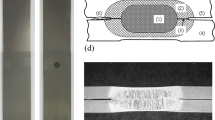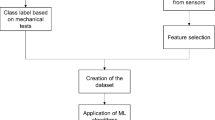Abstract
Electric resistance spot welding technology has been widely applied to join sheet metal parts in the automobile industry for ensuring light weight and strong integrity. Many experiments have been carried out to measure the static and dynamic strength of spot welds for application to motor vehicles. The experimental data showed that the dynamic strength of spot welds is a function of loading rate, specimen thickness, spot weld nugget size, specimen type and steel grade. For the safe design of vehicle structures, it is important to accurately predict the weld strength as a function of those variables. Due to complexities in spot welding and failure, the existing regression models formulate the spot weld strength as a function of loading rate only and suffer from low prediction accuracy. Based on a large database of experimental tests on dynamic strength of spot welds for high strength steels, six data-driven models are developed using the state-of-the-art machine learning technology to quantify the dynamic strength of spot welds. Specifically, by use of artificial neural network (ANN) with built-in learning functions and optimized algorithms, the machine learning method can learn the data pattern from the training data set and accurately predict the dynamic strength as a multi-variable function of loading rate, specimen thickness, and weld nugget size. Moreover, both simple and more complex architectures of ANN models in conjunction with three typical activation functions (i.e., Sigmoid, Tanh and ReLU) are utilized to model the dynamic strength of spot welds. Six data-driven ANN models of dynamic strength are thus developed using the training data set and validated using the testing data set, and then compared with those obtained by the regression method. The advantages and disadvantages of those models are discussed accordingly.





















Similar content being viewed by others
References
Arunchai T et al (2014) Resistance spot welding optimization based on artificial neural network. Int J Manuf Eng. https://doi.org/10.1155/2014/154784
Borhana AA et al (2012) Ductile failure prediction of spot-welded lap joint. Appl Mech Mater 165:285–289
Chao YJ (2003a) Ultimate strength and failure mechanisms of resistance spot weld subject to tensile, shear and combined tensile/shear loads. J Eng Mater Technol 125:125–132
Chao YJ (2003b) Failure mode of spot welds: interfacial vs pullout. Sci Technol Weld Join 8(2):133–137
Chao YJ (2008) Dynamic failure of resistance spot welds—issues, problems, and current research, SEM XI international congress and exposition on experimental and applied mechanics, pp. 5–8
Chao YJ, Wang K, Miller KW, Zhu XK (2010) Dynamic separation of resistance spot welded joints: Part I—experiments. Exp Mech 50:889–900
Donders S et al (2005) The effect of spot weld failure on dynamic vehicle performance. Sound Vib 39(4):16–24
Ewing KW, Cheresh M, Thompson R, Kynuchek P (1982) Static and impact strengths of spot-welded HSLA and low carbon steel joints, SAE technical paper 820281
Kumar UA (2005) Comparison of neural networks and regression analysis: a new insight. Expert Syst Appl 29:424–430
Larson CF (1972) Bibliography on resistance welding 1950–1971. Weld J 51(11):563–567
Lee Y et al (1998) Ultimate strength of resistance spot welds subject to combined tension and shear. J Test Eval 26(3):213–219
Lee KY et al (2017) Comparison and analysis of linear regression and artificial neural network. Int J Appl Eng Res 12(20):9820–9825
Lin SH, Pan J, Wu S, Tyan T (2004) Failure loads of spot weld specimens under impact opening and shear loading conditions. Exp Mech 44(2):147–157
Ma Y et al (2021) Measurement of local material properties and failure analysis of resistance spot welds of advanced high strength steel sheets. Mater Des 201:109505
Miller KW, Chao YJ, Martinez A, Zhu XK, Liu S, Wang PC (2003) Quasi-static and impact strength of fatigue damaged spot welds, SAE Paper 2003-01-0610, also in Welding and Joining, SP-1766
Nabi J (2018) Machine learning—fundamentals, online tutorial article at https://towardsdatascience.com/machine-learning-basics-part-1-a36d38c7916
Nwankpa CE et al (2018) Activation functions: comparison of trends in practice and research for deep learning. Preprint arXiv 1811:03378
Pandya KS et al (2020) Fracture response of resistance spot welded dual phase steel sheets: experiments and modeling. Int J Mech Sci 187:105869
Pollard B (1974) Spot welding characteristics of HSLA steel for automotive applications. Weld J 53(8):343–350
Pouranvari M, Marashi SPH (2012) Failure of resistance spot welds: tensile shear versus coach peel loading conditions. Ironmak Steelmak 39(2):104–111
Pouranvari M, Marashi SPH (2013) Critical review of automotive steels spot welding: process, structure and properties. Sci Technol Weld Join 18(5):361–403
Schneider F, Jones N (2003) Influence of spot weld failure on crushing of thin-walled structural sections. Int J Mech Sci 45:2061–2081
Sheikhi M et al (2020) Prediction of the failure mode of automotive steels resistance spot welds. Sci Technol Weld Join 25(6):511–517
Shojaee M et al (2021) Mechanical properties and failure behavior of resistance spot welded third-generation advanced high strength steels. J Manuf Process 65:365–372
Song JH, Huh H, Lim JH, Park SH (2008) Effect of tensile speed on the failure load of a spot weld under combined loading conditions. Int J Model Phys B 22:1469–1474
Tosun E, Calik A (2016) Failure load prediction of single lap adhesive joints using artificial neural networks. Alex Eng J 55:1341–1346
Vandenbossche DJ (1977) Ultimate strength and failure mode of spot welds in high strength steels, SAE technical paper 770214
Wan X et al (2017) Weld quality monitoring research in small scale resistance spot welding by dynamic resistance and neural network. Measurement 99:120–127
Wang K, Chao YJ, Zhu XK, Miller KW (2010) Dynamics separation of resistance spot welded joints: part II—analysis of test results and a model. Exp Mech 50:901–913
Wang W, Zhu Q, Liu C, Wei X (2019) An investigation on the resultant-based failure criterion for resistance spot welding joining in crash test. Int J Crashworthiness 24(2):152–162
Yang YP, Gould J, Peterson W, Orth F (2013) Development of spot weld failure parameters for full vehicle crack modeling. Sci Technol Weld Join 18(3):222–231
Zhao D, Wang Y, Liang D, Zhang P (2016) Modeling and process analysis of resistance spot welded DP600 joints based on regression analysis. Mater Des 110:676–684
Zhou H (2020) Learn data mining through excel: a step-by-step approach for understanding machine learning methods. Apress, New York
Zhou K, Yao P (2019) Overview of recent advances of process analysis and quality control in resistance spot welding. Mech Syst Signal Process 14:170–198
Zhu J (2016) Resistance weld strength characterized by lap-shear and cross-tension specimens, science project report. Upper Arlington High School, Columbus
Zhu JB, Zhu XK, Zhang W (2021) Machine learning modeling of dynamic strength of resistance spot welds in high strength steels, Proceedings of ASME pressure vessels and piping conference, virtual online, July 12–16, PVP2021–63093
Zolfaghari A, Izadi M (2020) Burst pressure prediction of cylindrical vessels using artificial neural network. J Press Vessel Technol 142:031303
Acknowledgements
The authors are grateful to Professor Bill Chao in the University of South Carolina for his helpful discussions on the resistance spot weld tests.
Author information
Authors and Affiliations
Corresponding author
Ethics declarations
Conflict of interest
There is no conflict of interest.
Additional information
Publisher's Note
Springer Nature remains neutral with regard to jurisdictional claims in published maps and institutional affiliations.
Rights and permissions
About this article
Cite this article
Zhu, XK., Zhu, J.B. & Zhang, W. Data-driven models of dynamic strength of resistance spot welds in high strength steels by regression and machine learning. Multiscale and Multidiscip. Model. Exp. and Des. 5, 337–350 (2022). https://doi.org/10.1007/s41939-022-00123-y
Received:
Accepted:
Published:
Issue Date:
DOI: https://doi.org/10.1007/s41939-022-00123-y




